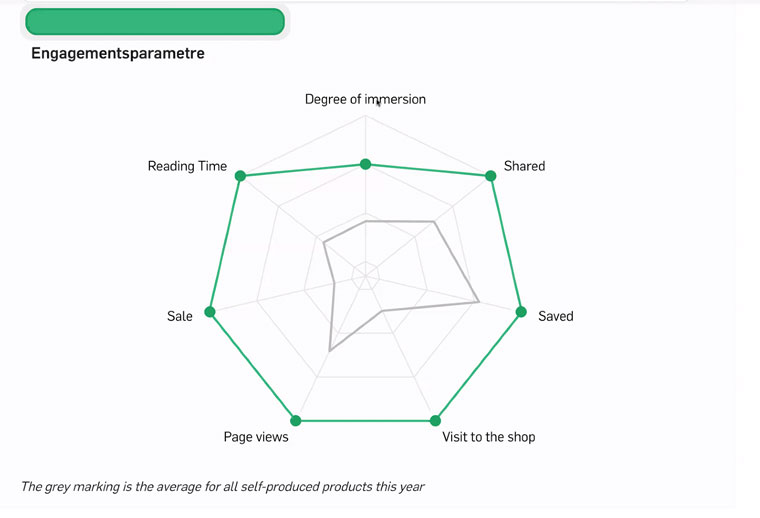Politiken offers a tour of its all‑purpose data dashboard
Newsroom Transformation Initiative Blog | 23 April 2025
When Politiken’s digital director Troels Behrendt Jørgensen shared information about the company’s in-house data tool during INMA’s Newsroom Transformation Town Hall last year, he piqued the interest of fellow members.
During this week’s Webinar, Jørgensen and developer/data scientist Mikkel Stampe Davidsen returned to share a full demonstration.
The Webinar, moderated by INMA Newsroom Transformation Initiative Lead Amalie Nash, offered important insights on a topic of growing importance to news media companies, she said: “One of the things I’m seeing more and more is the focus on quality metrics.”
As companies move away from traditional pageview metrics and turn their attention to things like quality reads, subscriber retention, return frequency, and time spent on the site during page visits, Nash said what news companies need to know has changed.
“It’s really about engagement and loyalty a lot more than it is about just understanding the volume of people coming to a Web site, especially for those companies that are focused on digital subscriptions,” she explained. “It really is about how do we have a more durable audience? How do we get that stickiness and circulate people around the site?”
Politiken’s tool, which was built in-house, mines information that goes beyond pageviews and top stories. Jørgensen introduced the features to INMA members, showing them how the dashboard works and how it provides actionable, reliable metrics designed for today’s audiences.

Analytics in every article
Politiken’s tool grew out of a need to discover “some of the finer and intricate things regarding content sales” and make it easier for people to access the data themselves.
Instead of visiting a separate dashboard to see how their stories are performing, reporters can view a bar at the bottom of every page that offers a shortcut to the CMS and a colour‑coded engagement metre, showing real-time data such as the number of page impressions, average reading time, and the number of subscriptions generated by the article.
Reporters can scroll through the article to see where engagement begins to fall off.

Then, by clicking the “Insights” link, the article reloads with a fresh treasure trove of real‑time data. At the heart of Insights is a bright‑green “spider web” chart, with each spoke representing one of seven signals:
- Degree of immersion (Politiken’s quality‑read definition).
- Social shares via the paywall “gift” function.
- Article saves.
- Visits to the subscription shop.
- Pageviews.
- Completed subscription sales.
- Average reading time.

The system converts those signals into an engagement score displayed on every story. The farther out the “web” reaches, the greater the engagement, Davidsen explained.
A short, lightly read brief can still reach “full green” if it converts readers to subscribers or generates unusually deep reading. Conversely, a high‑traffic article that visitors skim may only earn half marks.
“This spider web altogether is based on a point system, and the point system is setting the engagement score,” he said. Sometimes, a story may not extend to “full spider web” but could still have a full engagement score.
In addition to keeping everyone informed about story performance, leading to a better understanding about what type of coverage is working, engagement scores on every article is a way of “keeping up spirits,” Jørgensen said:
“When we introduced this score on every article, we were quite afraid that it might discourage people; maybe they felt it was a judgment over their work.”
To make it more positive, Politiken used a green bar.
The spider web page also includes a brief description of the article, the section it is published in, the topics it covers, and the user needs it serves. A graph tracks what kind of traffic was generated during the story’s first 48 hours, and stars on the graph indicate how many sales were generated directly from that story.
“We count sales from articles and it’s important for us, because we think it’s a really good engagement KPI,” Jørgensen said.
Gauges for front‑page editors
Politiken’s front page team receives its own real‑time dashboard, which displays four speedometers showing current click‑through rates, visits, pageviews, and subscription sales. A ranked list of live headlines reveals which items drive each KPI.
“Over time, what has become most important to the front-page editors is today’s CTR,” Jørgensen said. “This is where they feel they can make the most difference. If they doctor the headlines and put up a front page with appealing images and appealing headlines, the CTR will usually be better.”

The front-page dashboard shows a list of stories on the current front page. It also shows, in real-time, what devices are accessing the information, as well as the region and age group of the users.
The real-time data feed allows editors to react, Davidsen said.
“If we are good on pageviews and low on sales subscription sales, then the front-page editors will move up stories that are selling. They can take real-time action to make the benchmark for the day come true based on this. And also, we can do it from a strategic perspective. If we have bad sales in a month, then we’ll elevate the stories that we know sells better.”
Using user needs
Every story is assigned one of seven user needs (Explain It, Update Me, Entertain Me, Fascinate Me, Show Me the Human, Guide Me, or Show Me Opinions) before publishing.
“We have our own way of talking about user needs,” Jørgensen said, noting Politiken’s categories vary slightly from some other models.
The user needs model has been valuable for the newsroom, and the Insights page compiles 30‑day tables tracking how many stories each need receives and how those stories rank in terms of engagement, pageviews, and sales. For editorial managers, it offers insight into what is working and what type of stories are lacking.
“It is a way of having a discussion with your newsroom about are we producing the right amount of articles within each user need, and are there perhaps areas where we could do it differently?” Jørgensen said.
The size model
Politiken’s SML model tells reporters at the assignment stage how many characters, visuals, and data blocks each format requires, and it lets Insights tally performance by length.
“This model makes sure that once everything is proofread and published that it will eventually fit into our templates for print,” Jørgensen said. “It’s also easy for us to follow how well these different formats are doing on the Web site.”

The dashboard revealed, for example, that XXL narratives produce the strongest engagement and the highest subscription sales, even though Politiken produces fewer of those large articles.
“We have, I think, over the years perfected the art of writing the long-form story,” Jørgensen said. “We know that they perform a lot better than the rest of our content and they have the right amount of time on the front page.”
Then, he said, social channels are used to give them more traction.
Politiken has added a feature to display sources for each article so “… we can make aggregated data about the amount of female and male sources that we are using, and also where they come from,” Jørgensen said.
This data is being collected with help from AI, and Jørgensen said they are also adding information on the theme and angle of each story, and a new tool helps gauge how constructive the content is.
“In Denmark, we have a long ongoing discussion about how constructive the current state of journalism is and what we are doing,” he said. “This tool … is about approach.”






























